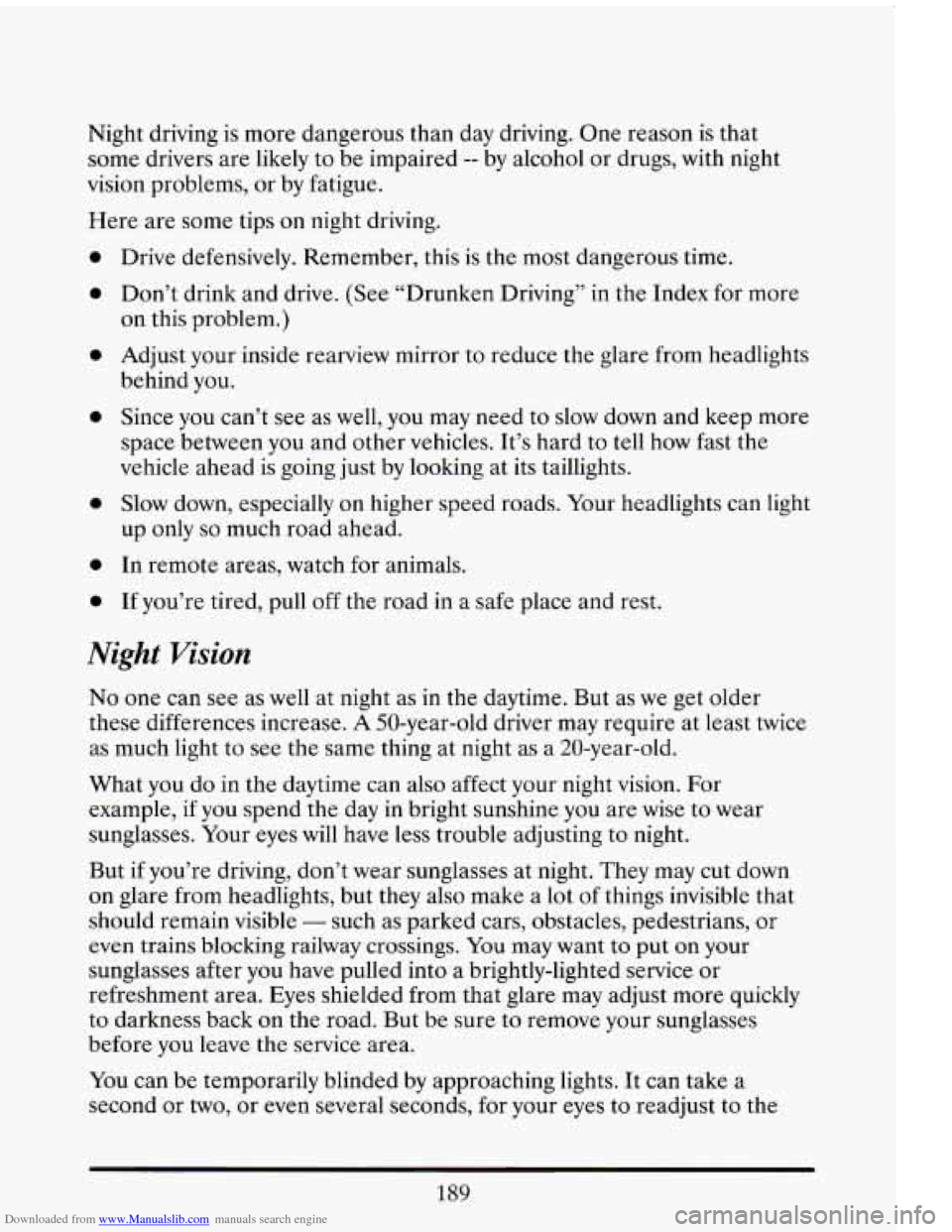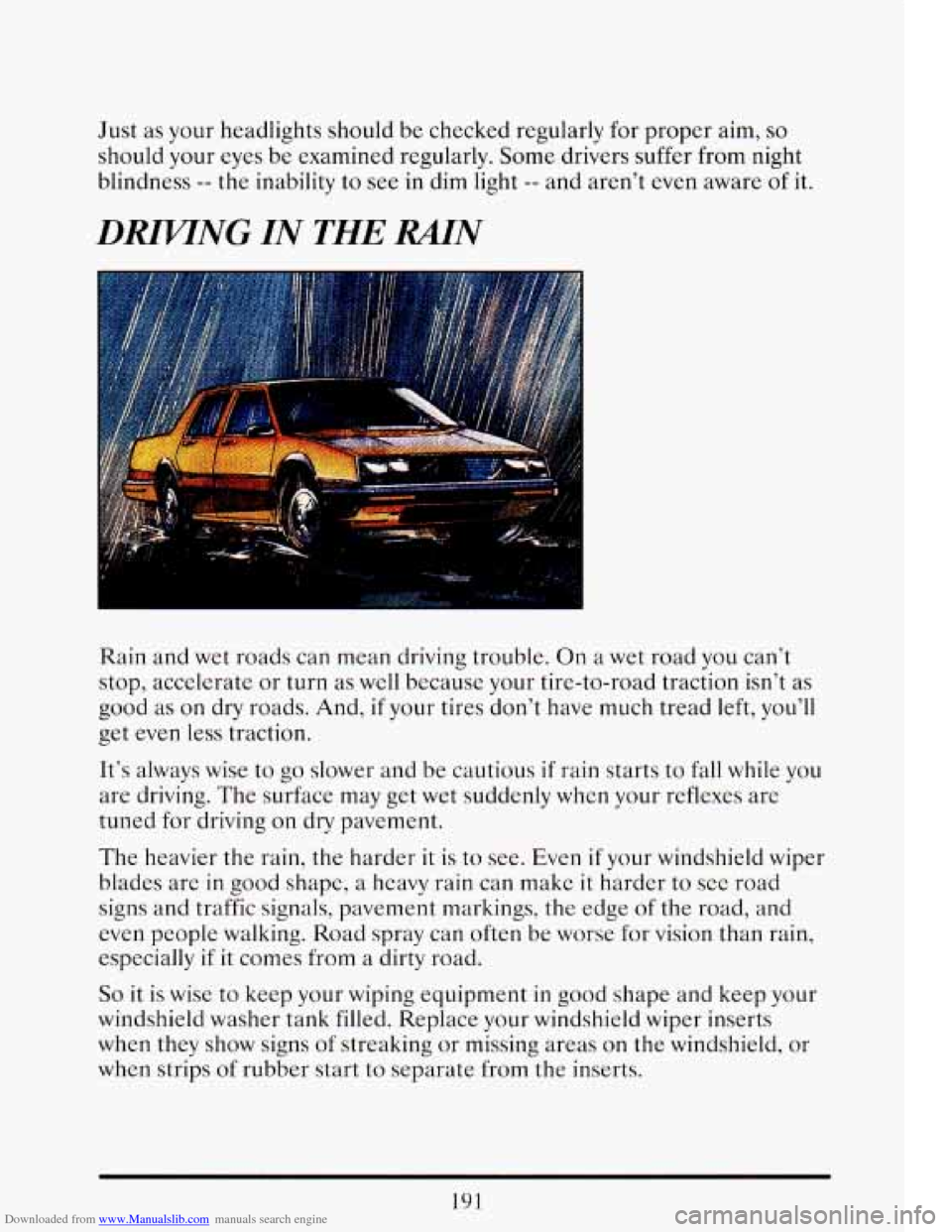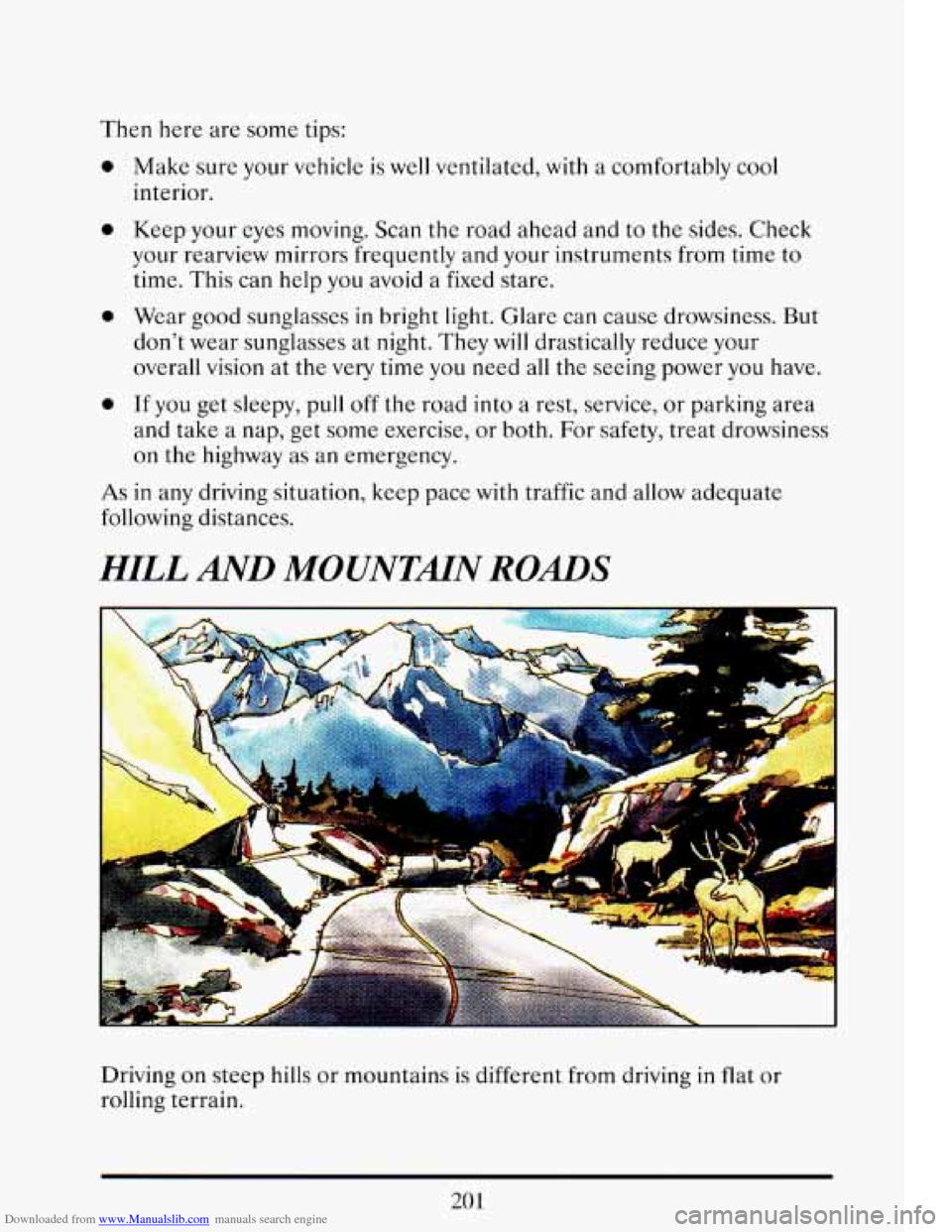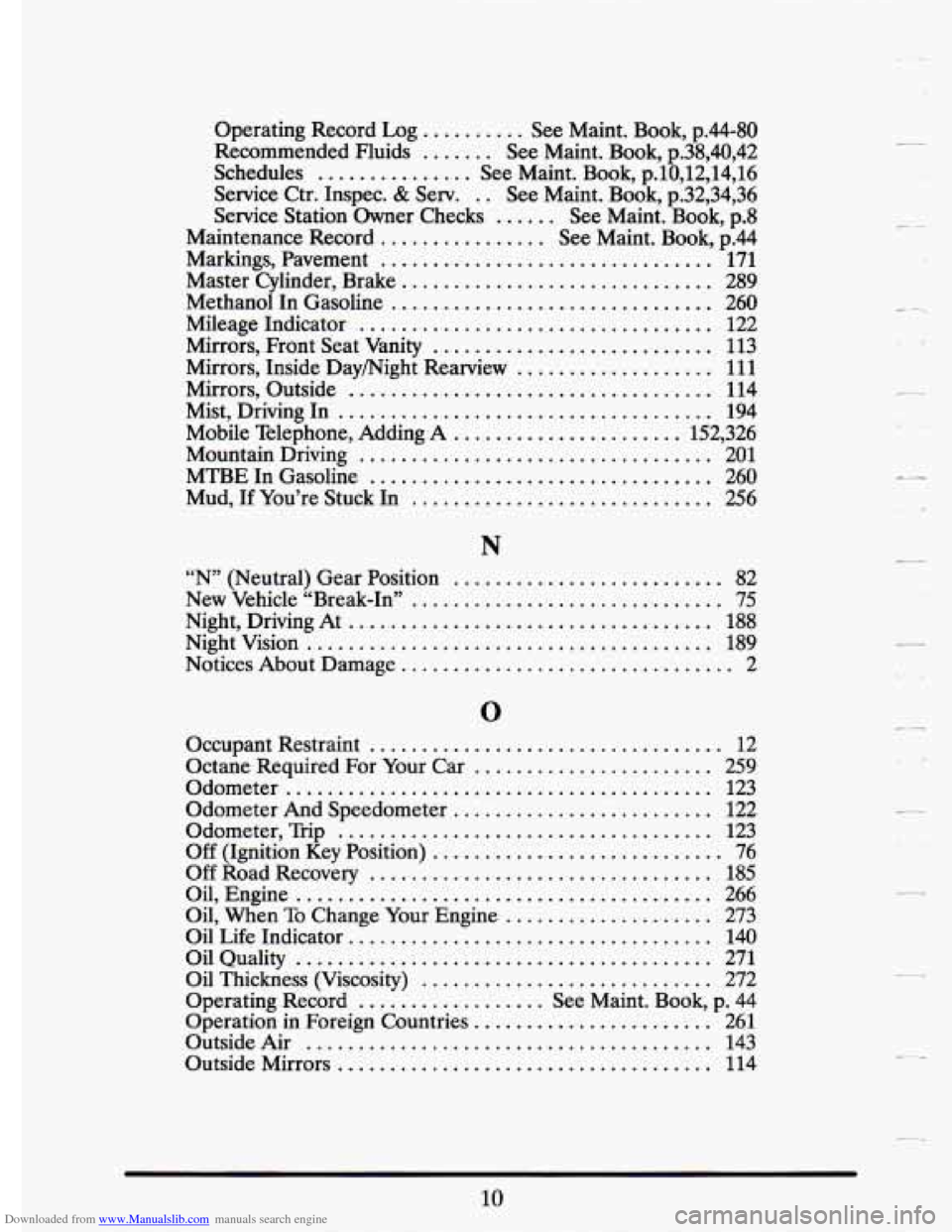1993 CADILLAC ELDORADO night vision
[x] Cancel search: night visionPage 203 of 398

Downloaded from www.Manualslib.com manuals search engine Night driving is more dangerous than day driving. One reason is that
some drivers are likely to be impaired
-- by alcohol or drugs, with night
vision problems, or by fatigue.
Here are some tips on night driving.
0
0
0
0
0
0
0
Drive defensively. Remember, this is the most dangerous time.
Don’t drink and drive. (See “Drunken Driving” in the Index for more
on this problem.)
Adjust your inside rearview mirror to reduce the glare from headlights
behind you.
Since you can’t see as well, you may need to slow down and keep more
space between you and other vehicles. It’s hard to tell how fast the
vehicle ahead is going just by looking at its taillights.
Slow down, especially on higher speed roads. Your headlights can light
up only
so much road ahead.
In remote areas, watch
for animals.
If you’re tired, pull off the road in a safe place and rest.
Night Vision
No one can see as well at night as in the daytime. But as we get older
these differences increase.
A 50-year-old driver may require at least twice
as much light to see the same thing
at night as a 20-year-old.
What you do in the daytime can
also affect your night vision. For
example, if you spend the day
in bright sunshine you are wise to wear
sunglasses. Your eyes will have
less trouble adjusting to night.
But if you’re driving, don’t wear sunglasses at night. They may cut down
on glare from headlights, but they also make a lot
of things invisible that
should remain visible
- such as parked cars, obstacles, pedestrians, or
even trains blocking railway crossings. You may want to put on your
sunglasses after you have pulled into a brightly-lighted service or
refreshment area. Eyes shielded from that glare may adjust more quickly
to darkness back on the road. But be sure to remove your sunglasses
before you leave the service area.
You can be temporarily blinded by approaching lights. It can take a
second or
two, or even several seconds, for your eyes to readjust to the
189
Page 204 of 398

Downloaded from www.Manualslib.com manuals search engine dark. When you are faced with severe glare (as from a driver who doesn’t
lower the high beams, or a vehicle with misaimed headlights), slow down
a little. Avoid staring directly into the approaching lights. If there
is a line
of opposing traffic, make occasional glances over the line
of headlights to
make certain that one
of the vehicles isn’t starting to move into your lane.
Once
you are past the bright lights, give your eyes time to readjust before
resuming speed.
High Beams
If the vehicle approaching you has its high beams on, signal by flicking
yours to high and then back to low beam. This is the usual signal
to lower
the headlight beams. If the other driver still doesn’t lower the beams,
resist the temptation to put your high beams on. This only makes two
half-blinded drivers.
On a freeway, use your high beams only in remote areas where you won’t
impair approaching drivers. In some places, like cities, using high beams
is illegal.
When you
follow another vehicle on a freeway or highway, use low
beams. True, most vehicles now have day-night mirrors that enable the
driver
to reduce glare. But outside mirrors are not of this type and high
beams from behind can bother the driver ahead.
A Few More Night Driving Suggestions
Keep your windshield and all the glass on your vehicle clean -- inside and
out. Glare at night
is made much worse by dirt on the glass. Even the
inside
of the glass can build up a film caused by dust. Tobacco smoke also
makes inside glass surfaces
very filmy and can be a vision hazard if it’s left
there.
Dirty glass makes lights dazzle and flash more than clean glass would,
making the pupils
of your eyes contract repeatedly. You might even want
to keep a cloth and some glass cleaner in your vehicle if you need to clean
your glass frequently.
Remember that your headlights light up far less of a roadway when you
are
in a turn or curve.
Keep your eyes moving; that way, it’s easier to pick out dimly lighted
objects.
190
Page 205 of 398

Downloaded from www.Manualslib.com manuals search engine Just as your headlights should be checked regularly for proper aim, so
should your eyes be examined regularly. Some drivers suffer from night
blindness
-- the inability to see in dim light -- and aren’t even aware of it.
DRn/lNG IN THE RAIN
Rain and wet roads can mean driving trouble. On a wet road you can’t
stop, accelerate or turn as well because your tire-to-road traction isn’t as
good
as on dry roads. And, if your tires don’t have much tread left, you’ll
get even less traction.
It’s always wise to go slower and be cautious if rain starts to fall while you
are driving. The surface may get wet suddenly when your reflexes are
tuned for driving on dry pavement.
The heavier the rain, the harder it is to see. Even if your windshield wiper
blades are
in good shape, a heavy rain can makc it harder to see road
signs and traffic signals, pavement markings, the edge
of the road, and
even people walking. Road spray can often be worse for vision than rain,
especially
if it comes from a dirty road.
So it is wise to keep your wiping equipment in good shape and keep your
windshield washer tank filled. Replace your windshield wiper inserts
when they show signs of streaking or missing areas on the windshield,
or
when strips of rubber start to separate from the inserts.
191
Page 215 of 398

Downloaded from www.Manualslib.com manuals search engine Then here are some tips:
0
0
0
0
Make sure your vehicle is well ventilated, with a comfortably cool
interior.
Keep your eyes moving. Scan
the road ahead and to the sides. Check
your rearview mirrors frequently and your instruments from time
to
time. This can help you avoid a fixed stare.
Wear good sunglasses in bright light. Glare can cause drowsiness. But
don’t wear sunglasses at night.
They will drastically reduce your
overall vision at the very time you need all the seeing power
you have.
If you get sleepy, pull
off the road into a rest, service, or parking area
and take a nap, get some exercise, or both. For safety, treat drowsiness
on the highway as an emergency.
As in any driving situation, keep pace with traffic and allow adequate
following distances.
HILL AND MOUNTMN ROADS
J
Driving on steep hills or mountains is different from driving in flat or
rolling terrain.
201
Page 390 of 398

Downloaded from www.Manualslib.com manuals search engine .
Operating Record Log .......... See Maint . Book. p.44-80
Recommended Fluids ....... See Maint . Book. p.38,40,42
Service Ctr . Inspec . & Sew ... See Maint . Book. p.32,34,36
Schedules ............... See Maint . Book. p.10,12,14,16
Service Station Owner Checks ...... See Maint . Book. p.8
Maintenance Record ................ See Maint . Book. p.44
Markings. Pavement ................................ 171
Master Cylinder. Brake .............................. 289
Methanol In Gasoline ............................... 260
Mileage Indicator .................................. 122
Mirrors. Inside Daymight Rearview ................... 111
Mirrors. Outside ................................... 114
Mist. Driving In .................................... 194
Mobile Telephone. Adding A ...................... 152. 326
Mountain Driving .................................. 201
MTBE In Gasoline ................................. 260
Mud. If You’re Stuck In ............................. 256
Mirrors. Front Seat Vanity ........................... 113
N
“N” (Neutral) Gear Position .......................... 82
New Vehicle “Break-In” .............................. 75
Night. Driving At ................................... 188
Night Vision ....................................... 189
Notices About Damage ................................ 2
.
.I
..
LA
..
LA
.
0
Occupant Restraint .................................. 12
Octane Required For Your Car ....................... 259
Odometer ......................................... 123
Odometer And Speedometer ......................... 122
Odometer. Trip .................................... 123
Off (Ignition Key Position) ............................ 76
Off Road Recovery ................................. 185
Oil. Engine ........................................ 266
Oil. When To Change Your Engine .................... 273
Oil Life Indicator ................................... 140
Oil Quality ........................................ 271
Oil Thickness (Viscosity) ............................ 272
Operating Record .................. See Maint . Book. p . 44
Operation in Foreign Countries ....................... 261
OutsideAir ....................................... 143
Outside Mirrors .................................... 114
.
L-
c-
..
.
...
10